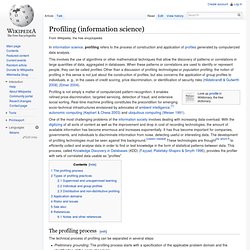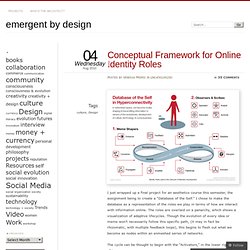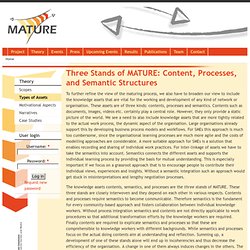

Disruptors. APML - Attention Profiling Mark-up Language: The open standard for Attention Metadata. Profiling practices. In information science, profiling refers to the process of construction and application of profiles generated by computerized data analysis.

The technical process of profiling can be separated in several steps: Data collection, preparation and mining all belong to the phase in which the profile is under construction. However, profiling also refers to the application of profiles, meaning the usage of profiles for the identification or categorization of groups or individual persons. As can be seen in step six (application), the process is circular. Database of the Self in Hyperconnectivity.
Enhancers. Conceptual Framework for Online Identity Roles. I just wrapped up a final project for an aesthetics course this semester, the assignment being to create a “Database of the Self.”

I chose to make the database as a representation of the roles we play in terms of how we interact with information online. The roles are overlaid on a panarchy, which shows a visualization of adaptive lifecycles. Though the evolution of every idea or meme won’t necessarily follow this specific path, (it may in fact be rhizomatic, with multiple feedback loops), this begins to flesh out what we become as nodes within an enmeshed series of networks. The cycle can be thought to begin with the “Activators,” in the lower right side of image. For an interactive version of the graphic, click here. I found this to be an interesting exercise when thinking about the impact and influence we have on the web, and how information travels.
Thanks to @wildcat2030 for inspiration from Friendships in Hyperconnectivity mindmap and to @gavinkeech for visual design. Like this: Friendship in Hyperconnectivity. Mapping hyperconnectivity – Conceptual Framework for Online Identity Roles [04Aug10]
Assimilators. Connectors. Propagators. MATURE Conceptual Model. Panarchy. Three Stands of MATURE: Content, Processes, and Semantic Structures. To further refine the view of the maturing process, we also have to broaden our view to include the knowledge assets that are vital for the working and development of any kind of network or organisation.

These assets are of three kinds: contents, processes and semantics. Contents such as documents, images, videos etc. certainly play a central role. However, they only provide a static picture of the world. We see a need to also include knowledge assets that are more tightly related to the actual work process, the dynamic aspect of the organisation. Large organisations already support this by developing business process models and workflows. The knowledge assets contents, semantics, and processes are the three stands of MATURE.
Roles & Functions... Collaboration. [This article is crossposted from Jorge Jaime's blog, in response to my video post a few weeks back about "The Conversation.

" I recorded an hour long chat on skype with Scott Lewis (@jazzmann91), broken down into 5 minute clips, in which we discussed the concept behind Junto. Namely, it is a conversation platform we are inspiring to be built around the intention of creating a respectful space where people can engage in generative dialogue and come to a place of understanding and shared meaning. Scott and I discussed what that looks like, and what kind of core values people may embrace in order to have meaningful, productive conversations that lead to positive action. In the comments section of that post, Jorge suggested someone break down the content of the discussion so that others could learn from it. I suggested he do it.
A week ago Venessa Miemis shared a conversation where she spoke with @jazzmann91. Design Thinking > Collaboration – Memetic Cartography. Guidelines for Group Collaboration and Emergence. I’m in the middle of taking a course on Virtual Learning Environments (syllabus here), and reading a few chapters from Adaptive Software Development by Highsmith.

It approaches the team-building and collaboration process from the perspective of complex adaptive systems theory, and contains some interesting insights in evolutionary development and creating environments where emergence can occur. I’ve created a summary of a chapter that I’d like to share, as I think it can be valuable for many of us, and specifically for the community of practitioners around the junto concept. Collaboration is an act of shared creation or discovery. (schrage89) As a distributed group of individuals (agents) within a network, we form a complex adaptive system.
Pathfinders.